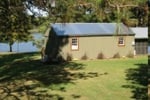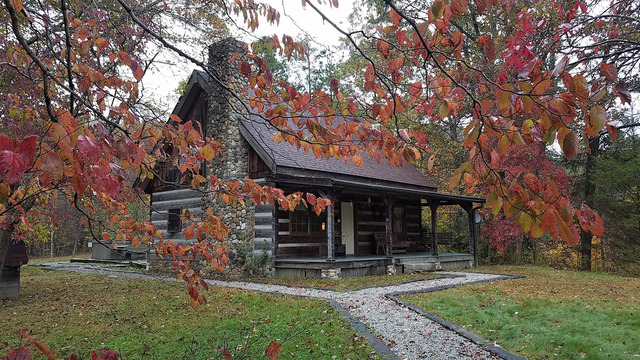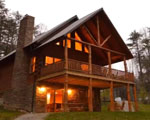LAKE LOGAN STATE PARK
One of the best fishing lakes in Ohio awaits sportsmen in Hocking County at Lake Logan State Park. The lake sports northern pike, bass, bluegill, crappie, catfish and saugeye. Lake Logan is a day-use park that provides scenic picnic areas and secluded walking paths to enjoy the wooded beauty of Ohio's hill country.
Much time has passed since the region surrounding Lake Logan was first uplifted from the ancient sea that once covered most of Ohio. This unglaciated plateau in the southeastern part of the state is Ohio's oldest landscape as the glaciers never invaded the region. Lake Logan State Park lies in the Hocking Valley, formed by the Hocking River. The Hocking was a major outlet for glacial meltwaters. These waters deposited large amounts of outwash material, primarily sand and gravel, which strongly affected the type of biological communities present today.
The forest surrounding Lake Logan is for the most part an oak-hickory association. White and black oak, tuliptree, shagbark and pignut hickory are the most dominant species. The forest floor is dotted with a variety of wildflowers such as fire pink, wintergreen, bluets and spring beauties. Ground cover plants include greenbriar, blueberry and numerous ferns and fungi.
Lake Logan is home to the raccoon, opossum, skunk, red-backed salamander, gray squirrel, box turtle, white-tailed deer and wild turkey. Many birds frequent the area such as the turkey vulture, red-tailed hawk, barn owl, pileated woodpecker, Carolina chickadee, tufted titmouse, wood thrush and scarlet tanager. Various species of waterfowl can be viewed during migration.
Lake Logan is located in Hocking County in southeastern Ohio. This territory once belonged to the Wyandot Indians, who had a large village known as Oldtown on the Hocking River, one mile above the city of Logan. Logan was established by Thomas Worthington in 1816 and named for the Mingo Chief, James John Logan, who was well known at first for his friendship with the whites and later for his bitter animosity toward them following the murder of his entire family by a frontier trapper named Greathouse.
The Hocking River provided sufficient water power for the purpose of operating grist and sawmills particularly at the falls above Logan. The town of Logan was slow to progress until the opening of the Hocking Canal, a branch of the Ohio-Erie Canal, in 1838. Several industries prospered due to the rich mineral resources of the Hocking Valley.
The discovery of immense quantities of coal led to the flourishing mining industry. Towns appeared and vanished as quickly as mines opened and closed.
It was soon found that iron ore could be extracted from the sandstone bedrock of the area. At its height during the Civil War, Ohio was the leading producer of iron for implements and weapons. No less than forty-six furnaces were firing in Ohio's six-county Hanging Rock Iron Region.
The clay soils of the Hocking Valley helped Ohio become a leader in clay products. The firebrick industry of the valley manufactured such products as clay tile, building and paving bricks and clay sewer pipe. Evidence of the industry can be seen in the many brick houses and abandoned kilns of the area. Clay is still an important industry in the region.
Lake Logan was developed in 1955 for recreational purposes. The area was administered by the ODNR Division of Wildlife until 1964, when jurisdiction was
transferred to the Division of Parks and Recreation. Originally known as Hocking Lake, it was re-named Lake Logan to reflect the Indian heritage of the area and to avoid confusion with nearby Hocking Hills State Park and Forest.
Ohio does not have an annual pass and does not charge entrance fees to state parks.
GeneralLand, acres318
Water, acres400
Nearby State Forest, acres9,238
Day-UseFishingyes
Huntingyes
Hiking Trail, miles3
Picnickingyes
Swimming Beach, feet527
Beach Concessionyes
BoatingBoat Rentalyes
Boating Limits10
Seasonal Dock Rental187
Launch Ramps, #2
WinterSleddingyes
Ice Skatingyes
Ice Fishingyes

Cottages and Cabins
A lakeside retreat in the beautiful Hocking Hills on scenic Lake Logan. Full kitchen, Hot Tub, Satellite HD TV, sitting room, breakfast nook, and electric AC/Heat.
0.6 miles from park*

Cottages and Cabins
Hidden Cave Cabin is an authentic log cabin with 2 bedrooms in a private wooded setting. It is located on one of the most scenic drives in Hocking Hills and just 3.6 miles to Rock House and less than 10 miles to Conkle's Hollow and Old Man's Cave.
7 miles from park*

Cottages and Cabins
Trickle Creek offers luxury cabins in Hocking Hills. The cabins are situated on nearly 236 acres of secluded cabin rentals in the deep wooded ravines in the foothills of the Appalachian Mountains in Hocking County, Ohio.
4.2 miles from park*
A 527-foot public swimming beach is located on the north shore of the lake on Lake Logan Road (C.R. 3). Facilities include a concession area, drinking water, restrooms and change booths.
Boats with motors up to 10 horsepower are permitted on the lake. A speed limit of 10 mph is enforced. Sailboating is also popular. Boat tie-ups can be rented at the park office. A launch ramp and boat tie-ups for picnicking fishermen are conveniently located at four of the many picnic areas in the park. Boat docks are also available on a rental basis.
The lake has abundant populations of bluegill, crappie, bass, muskie, catfish, northern pike and saugeye. Fox, squirrel, raccoon, rabbit, deer, waterfowl, turkey and ruffed grouse may be hunted in season. A valid Ohio fishing and/or hunting license is required.






